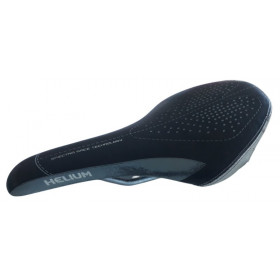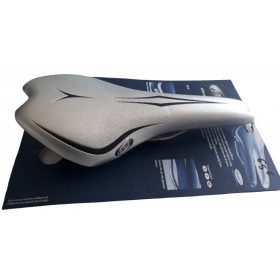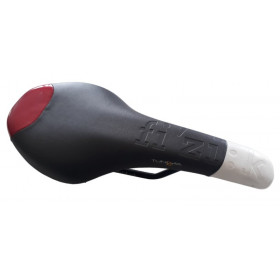There are 5 products.
-
 UsedHelium Spectra race saddle
UsedHelium Spectra race saddle- €4.99
-
 UsedRockrider saddle
UsedRockrider saddle- €4.99
-
 New product -45%BBB ultrabase saddle
New product -45%BBB ultrabase saddle- €35.74
- €64.99
-
 New product -40%Fizik Pave CX saddle manganeses rails
New product -40%Fizik Pave CX saddle manganeses rails- €47.99
- €79.99
-
 More detailsNew product -60% Out-of-StockFizik Tundra 2 black and red saddle
More detailsNew product -60% Out-of-StockFizik Tundra 2 black and red saddle- €48.00
- €119.99
Showing 1-5 of 5 item(s)
In MTB enduro, the saddle plays a crucial role for comfort on long climbs, stability on descents and overall maneuverability of the bike, so it is key MTB enduro equipment. A poorly adapted MTB enduro saddle can not only cause discomfort, but also affect your performance. Here is a detailed guide to enduro mountain bike saddles.
Characteristics of an MTB enduro saddle
1. Shape and design
Short profile: Shorter saddles allow better mobility for the cyclist, especially during technical descents.Narrow or widened base: To adapt to the anatomy and offer optimal comfort when going up or down.
2. Padding
Medium to firm cushioning: Ideal for absorbing vibrations without affecting energy transmission.EVA or gel foam: Often used to provide a balance between comfort and lightness.
3. Rails
Rail material:Chromoly steel: Durable and affordable.
Titanium: Light and resistant, suitable for intensive practices.
Carbon: Ultra-light, but often more expensive.
Integrated suspension: Some saddles include rails designed to absorb shock.
4. Coating
Non-slip surface: Helps maintain a good position, even on uneven terrain.Weather resistance: Some models are covered with waterproof and wear-resistant materials.
5. Width and ergonomics
Available in several sizes to fit different body shapes.Ergonomic design to reduce pressure on the pelvis and improve circulation.
Best brands and models of MTB enduro saddles
1. Selle Italia
Model: SLR Boost X-CrossStrong points: Short design, side reinforcements to protect against impacts.
Features: Titanium rails, light weight (~200 g), durable coating.
Advantages: Ideal for technical descents and long outings.
2. Fizik
Model: Alpaca Terra X5Strong points: Ergonomic shape, designed for uneven terrain.
Features: Aluminum rails, EVA foam padding, non-slip coating.
Advantages: Optimal comfort for long climbs and controlled descents.
3. Ergon
Model: SM Enduro ProStrong points: Design focused on enduro performance.
Features: Titanium rails, nylon reinforced base, high density foam.
Benefits: Relieves pressure points, excellent vibration absorption.
4. WTB (Wilderness Trail Bikes)
Model: VoltStrong points: Versatile, compatible with intensive practices.
Features: Chromoly or titanium steel rails, thick padding, microfiber covering.
Advantages: Comfort and stability for extended outings.
5.PRO
Model: Stealth OffroadStrong points: Short profile, designed for technical disciplines.
Features: Carbon or stainless steel rails, EVA padding, central channel to reduce pressure.
Advantages: Lightness and excellent mobility.
6. SDG Components
Model: Bel-Air 3.0Strong points: Increased comfort thanks to optimized padding.
Characteristics: Titanium or steel rails, resistant coating, side reinforcements.
Advantages: Ideal for long enduro rides.
Selection criteria for an MTB enduro saddle
Comfort: Opt for an MTB enduro saddle adapted to your body shape (measure your ischial distance).Durability: Choose resistant materials for intensive use.
Lightweight: A lightweight saddle helps keep the bike maneuverable.
Ergonomics: Good pressure distribution and freedom of movement are essential.
Compatibility: Check the dimensions and type of rails against your seat post.
Tips for installing and maintaining an MTB enduro saddle
Positioning: Adjust the MTB enduro saddle to your preferred angle and height to avoid pain.Maintenance: Clean regularly with suitable products to preserve the coating.
Checking the rails: Make sure they are not cracked or worn after each ride.
With the right saddle, your enduro mountain bike rides will be synonymous with comfort and performance, even on the most demanding terrain.
